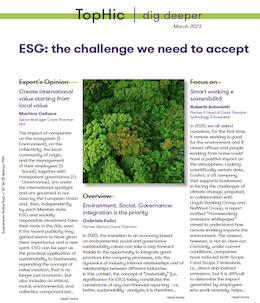-
Transactional advisory services
Find out more about the transactional advisory services of Grant Thornton Financial Advisory Services
-
Valuations
Find out more about the valuations services of Grant Thornton Financial Advisory Services
-
Mergers and acquisitions
Find out more about the merger and acquisition services of Grant Thornton Financial Advisory Services
-
Forensic and investigation services
Find out more about the forensic and investigation services of Grant Thornton Financial Advisory Services
-
Recovery & reorganisation
Find out more about the Recovery & reorganisation services of Grant Thornton Financial Advisory Services
-
Business risk services
Find out more about the business risk services of Grant Thornton Financial Advisory Services
-
Business consulting
Find out more about the business consulting services of Grant Thornton Financial Advisory Services
-
Capital market
Capital market
-
Corporate and business tax
Find out more about our corporate and business tax services.
-
Direct international tax
Find out more about our direct international tax services.
-
Global mobility services
Find out more about our global mobility services.
-
Indirect international tax
Find out more about our indirect international tax services.
-
Transfer pricing
Find out more about our transfer pricing services.
-
Litigation
Our lawyers and accountants can manage all defense measures provided not only by the Italian law, but also by EU regulations and conventions
-
Family business
Find out more about our Family business services.
-
Legal
The client can be assisted in every need and with the same care both on important operations or disputes and on simple matters

-
Back office outsourcing
Find out more about our Back office outsourcing services
-
Business process outsourcing
Find out more about our business process outsourcing services.
-
Compilation of financial statements
Find out more about our compilation of financial statements services.
-
Tax compliance
Find out more about our tax compliance services.
-
Electronic invoicing
Find out more about our electronic invoicing services
-
Electronic storage
Electronic storage is an archiving procedure that guarantees the legal validity of a digitally stored electronic document
-
Revaluation of corporate assets
Find out your civil and fiscal revaluation of tangible, intangible and financial assets
-
Human resources consulting
Find out more about our human resources consulting services.
-
Payroll
Find out more about our payroll services.
-
HR News
HR News the monthly information newsletter by Grant Thornton HR
-
Cybersecurity
GT Digital helps clients structure information security management internal functions, also through partially or totally outsourced functions
-
Agile and Programme Management
GT Digital provides support in the adoption and implementation of different portfolio management
-
Robotic Process Automation
Our “BOT Farm” can rely on digital workers able to help clients in routine activities, allowing employees to deal with more added-value activities
-
Data strategy and management
GT Digital can support clients in seizing the opportunities offered by Big Data, from the definition of strategies to the implementation of systems
-
Enterprise Resource Planning
We support clients in selecting the most appropriate ERP System according to their specific needs, helping them also understand licensing models
-
IT strategy
GT Digital supports clients in making strategic choices, identifying innovation opportunities, comparing themselves with competitors
-
IT service management
We can support with software selection and with the implementation of dedicated tools for the management of ICT processes
-
DORA and NIS 2
The entry into force of the DORA Regulation and NIS2 represents a major step towards the creation of a harmonised regulatory framework
In 2020, we all asked ourselves, for the first time, if remote working is good for the environment and if closed offices and people working from home could have a positive impact on the atmosphere. Lacking scientifically certain data, EcoAct, a US company that supports businesses in facing the challenges of climate change, prepared, in collaboration with Lloyds Banking Group and NatWest Group, a report entitled "Homeworking emissions whitepaper" aimed to understand how remote working impacts the environment. The answer, however, is not so clear-cut.
Certainly, under current conditions, companies have reduced both Scope 1 and Scope 2 emissions, i.e., direct and indirect emissions, but it is difficult to determine the impact generated by employees who work remotely. However, the report still helps to reach an answer by identifying those indicators that can define the environmental impact of remote working.
The first indicator is the energy consumption derived from the use of electronic devices that are necessary for the performance of daily work activities by each employee. To obtain some data, we should consider that a laptop has an energy consumption that ranges from 50 to 100Wh and, therefore, if used for 8 hours a day, its annual consumption ranges from 150 to 300kWh, which generates approximately 150-300 kWh of CO2, based on the Italian energy efficiency ratio of 0.3 – 0.4.
The second indicator is the consumption for heating due to the fact that people are forced to increase their use. With this regard, we should consider that energy sources consumed are both natural gas and electricity.
The third indicator is the energy consumed for home cooling. In this case, only emissions from electricity consumption will be considered.
Lastly, we should consider the number of remote working days in a working week, for this purpose we will introduce the concept of "remote working FTE", according to which an employee who works remotely 2 days out of 5 is indicated with 0.4 remote Working FTE.
In terms of savings, remote working allows avoiding emission for about 600 kilograms of carbon dioxide per year per worker (-40% compared to 2018) with significant savings in terms of time (about 150 hours), travelled distance (3,500 km) and fuel (260 litres of petrol or 237 litres of diesel). This is what emerges from ENEA research on the environmental impact of remote working in Rome, Turin, Bologna, and Trento in the four-year period 2015-2018, published in the international magazine Applied Sciences.
"In our country, about one person out of two owns a car, i.e., 666 cars every 1,000 inhabitants, thus Italy ranks second in Europe among the countries with the highest rate of motorisation, after Luxembourg", explained Roberta Roberto, ENEA researcher in the Energy technologies and renewable sources Department and co-author of the survey, together with her colleagues from other ENEA departments Bruna Felici, Alessandro Zini and Marco Rao.
In Italy, transport is responsible for over 25% of total national greenhouse gas emissions and almost all of them (93%) come from road transport and mainly from cars (70%). “Agile working and all other forms of remote working have shown that they can be an important instrument for change, capable not only of improving professional and personal life quality, but also of reducing traffic and city pollution and to revive peripheral areas”, added Roberta.
Based on the responses of a sample of 1,269 agile workers in the PA in the four cities examined, who use private internal combustion vehicles for commuting from home to work, every remote working day would make it possible to avoid 6 kg of direct emissions of CO2 and to save 85 megajoules (MJ) of fuel per capita. But there are also other environmental benefits: the analysis also highlighted a reduction in nitrogen oxides per person per day (from 14.8 g in Trento to 7.9 g in Turin), carbon monoxide (from 38.9 g in Rome to 18.7 g in Trento) and PM10 (from 1.6 g in Rome to 0.9 g in Turin), PM2.5 (from 1.1 g in Rome and Trento to 0.6 g in Turin). Furthermore, 24.8% of respondents declared that they opted for more sustainable transport means (public transport, bicycle, or on foot) for travel outside work during remote working days, 8.7% of them changed their choices in favour of private transport, while 66.5% did not change their means of transport.
"We chose these four cities for two reasons: firstly, for their peculiarities linked to the territory and the historical profile which could lead to diversified impacts on urban mobility and, secondly, due to the high number of responses to the questionnaire received from public sector employees in these four cities, who work from home 2 days a week on average”, underlined Bruna Felici, ENEA researcher in the Studies, Analysis and Evaluations Unit.
Collected data suggest that, on average, respondents travel 35 km a day for 1 hour and 20 minutes. Rome is confirmed as the most critical city, with an average travel time equal to 2 hours, probably due to greater distances (1 out of 5 workers travel more than 100 km a day) and more intense traffic. In fact, in Rome there are around 420,000 daily trips for work and study reasons, while each person spends 82 hours a year stuck in the traffic.
About half of respondents declared that they travel exclusively with private motor vehicles (47% by car and 2% by motorcycles), while 17% travel exclusively with public transport and 16% with a mix of public and private transport. In Trento there is the greatest use of private internal combustion vehicles for home-work travel (62.9%), followed by Rome (54.4%), Bologna (44.9%) and Turin (38.2%). “Private mobility offers flexible solutions in terms of time savings and freedom of movement, especially for those having school-age children. Public transport, on the other hand, is mainly chosen with a view to saving money or in the event of a lack of parking spaces", concluded Alessandro Zini, ENEA researcher in the Studies, Analysis and Evaluations Unit.
In conclusion, there is no certain answer to whether smart working is good for the environment, but each company can apply the criteria described according to the characteristics of their employees and therefore identify the most effective application of remote working and the incentivization of certain transport means to reach the workplace.

